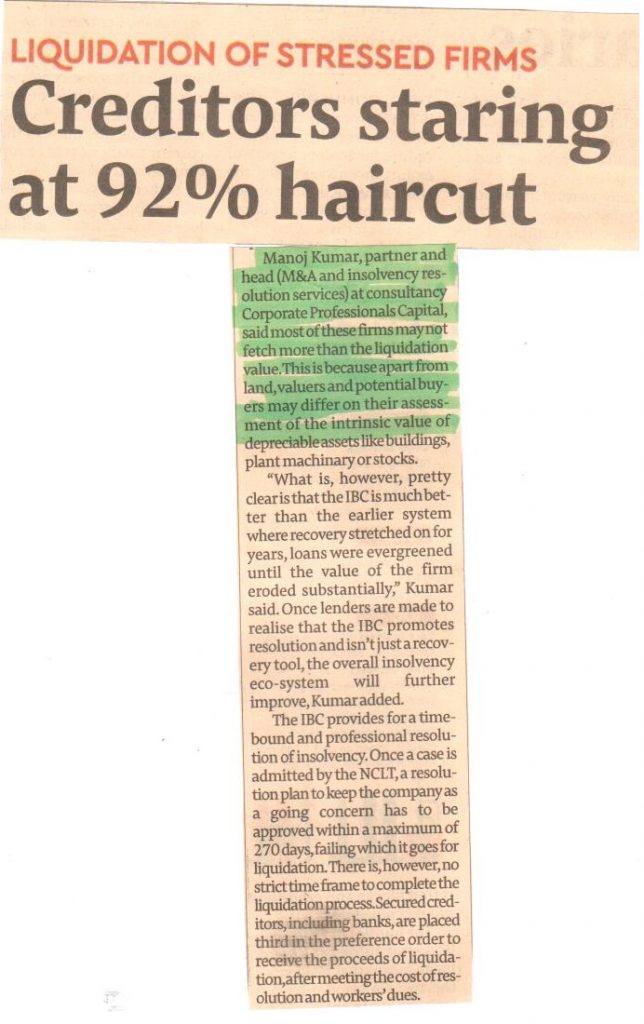
Creditors, mainly banks, are staring at the prospect of an average haircut of 92% in 124 of the 136 stressed firms that were facing liquidation under the Insolvency and Bankruptcy Code (IBC) at the end of the June quarter due to the absence of resolution plans to turn them around, according to the data compiled by the Insolvency and Bankruptcy Board of India (IBBI).
The liquidation value of the 124 companies has been pegged at just Rs 4,817 crore, while the total admitted claims of creditors (both financial and operational) stand at Rs 57,121 crore. The liquidation values of a dozen others were yet to be determined, although the total admitted debt involving all the 136 stressed firms stood at Rs 57,378 crore, showed the IBBI data, based on inputs from resolution professionals.
By contrast, creditors recovered Rs 49,783 crore, or almost 56% of their admitted claims, from 32 stressed companies where insolvency resolution plans were approved by the National Company Law Tribunal (NCLT) by the end of June.
Commenting on liquidation, IBBI chairman MS Sahoo told FE: “The not-so-good results in the initial set of cases is no indication of the performance of the IBC. As and when fresh cases of defaults regularly come up for being admitted, the resolution performance of the IBC will look much more impressive.”
More importantly, Sahoo said, “Going forward, the best use of the IBC will be not to use it at all. The inevitable consequence of a resolution process that a promoter and the management of a corporate debtor vests in a third party, which would bring in behavioural changes, is discouraging the debtors from committing defaults.”
Analysts also termed the massive haircut in old cases unavoidable, given that most of these companies had been stressed for years before the IBC came into being in 2016. So liquidation at scrap value was the only natural outcome. The huge haircut in such cases, however, only reinforces the indispensability of the IBC, they concede. This is because the IBC promotes resolution and gives the chance to lenders to invoke insolvency at the very first default when chances of turning around the stressed firms are much higher, and recovery prospects much better.
The total admitted claims of financial creditors, such as banks, were to the tune of Rs 52,671 crore, or close to 92% of all admitted claims in all these 136 sick firms . Claims of operational creditors — including raw material suppliers — stood at Rs 4,967 crore. Some of the key stressed firms that are undergoing liquidation are REI Agro, with total admitted debt of Rs 8,626 crore, Gujarat NRE Coke (Rs 5,251 crore), Rotomac Global (Rs 3,944 crore), Roofit Industries (Rs 3,943 crore), Gupta Coal India (Rs 3,895 crore), Gupta Corporation (Rs 3,561 crore), JODPL (Rs 3,011 crore), Rotomac Exports (Rs 2,886 crore), Jenson & Nicholson India (Rs 2,899 crore) and Lohaa Ispat (Rs 2,081 crore). These debt amounts include claims of both financial and operational creditors.
Manoj Kumar, partner and head (M&A and insolvency resolution services) at consultancy Corporate Professionals Capital, said most of these firms may not fetch more than the liquidation value. This is because apart from land, valuers and potential buyers may differ on their assessment of the intrinsic value of depreciable assets like buildings, plant machinary or stocks.
“What is, however, pretty clear is that the IBC is much better than the earlier system where recovery stretched on for years, loans were evergreened until the value of the firm eroded substantially,” Kumar said. Once lenders are made to realise that the IBC promotes resolution and isn’t just a recovery tool, the overall insolvency eco-system will further improve, Kumar added.
